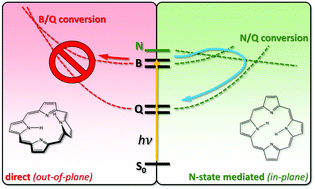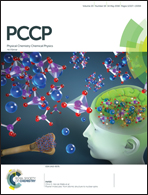Ultrafast photochemistry of free-base porphyrin: a theoretical investigation of B → Q internal conversion mediated by dark states†
Abstract
We examine the mechanism of ultrafast internal conversion between the B band (Soret band) and the Q band in porphine (H2P), the prototypical free-base porphyrin, using electronic structure studies and on-the-fly surface-hopping nonadiabatic dynamics. Our study highlights the crucial role of dark states within the N band which are found to mediate B/Q state transfer, necessitating a treatment beyond Gouterman's classic four-orbital model. The sequential B → N → Q pathway dominates largely over the direct B → Q pathway which is found to be energetically unfavorable. Potential energy surface cuts and conical intersections between excited states are determined by TDDFT and validated by CASSCF/CASPT2 and XMCQDPT2 calculations. Both the static analysis and on-the-fly surface-hopping calculations suggest a pathway which involves minor structural deformations via in-plane vibrations. The B → N conversion is a barrierless adiabatic process occurring within ∼20 fs, while the subsequent N → Q conversion occurs via a conical intersection within ∼100 fs, in agreement with time-resolved experiments for porphine and related free base porphyrins. Furthermore, evidence for both sequential and direct transfer to the Qx and Qy states is obtained.

- This article is part of the themed collection: 2018 PCCP HOT Articles


 Please wait while we load your content...
Please wait while we load your content...